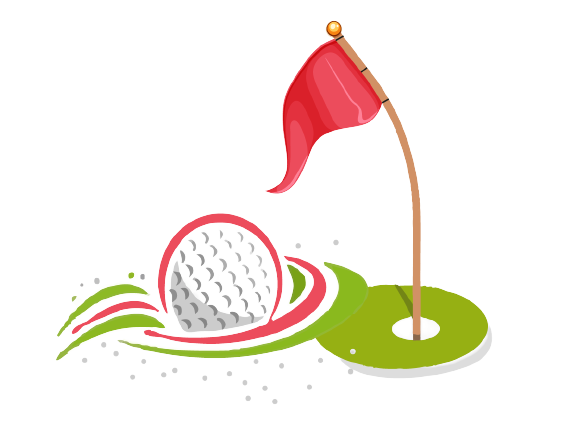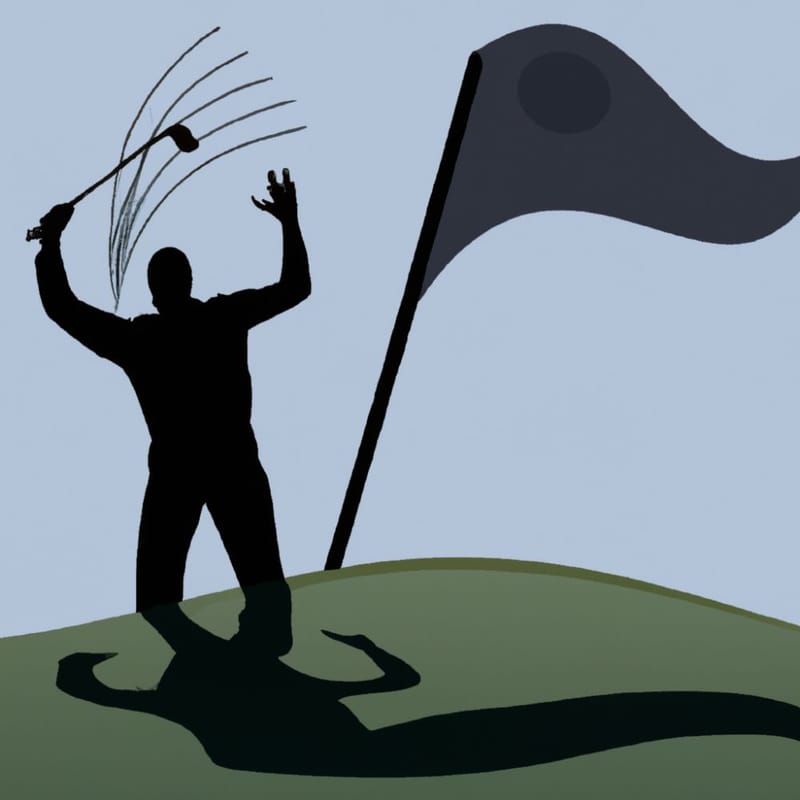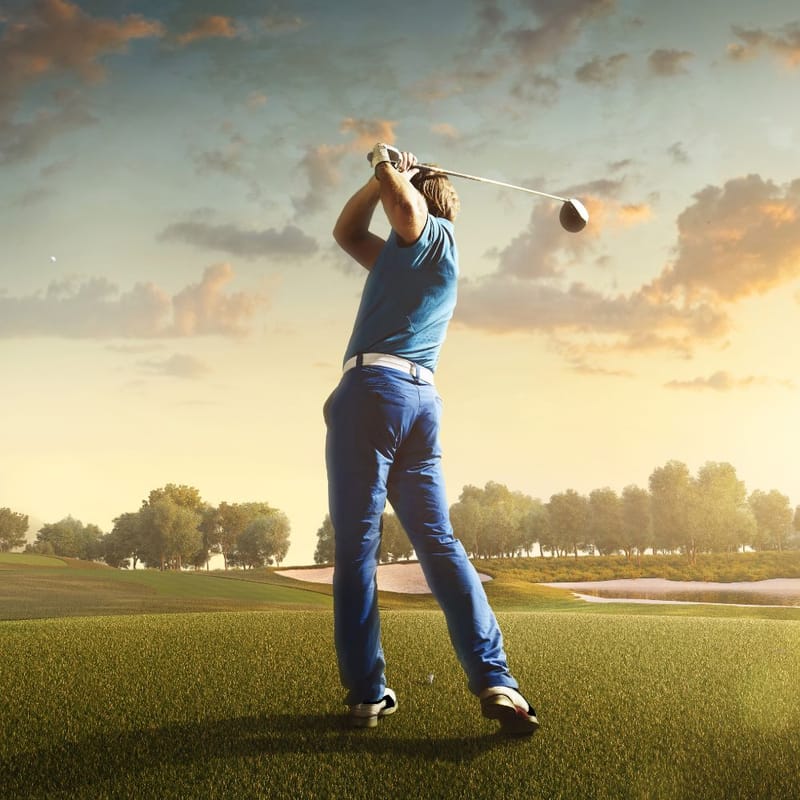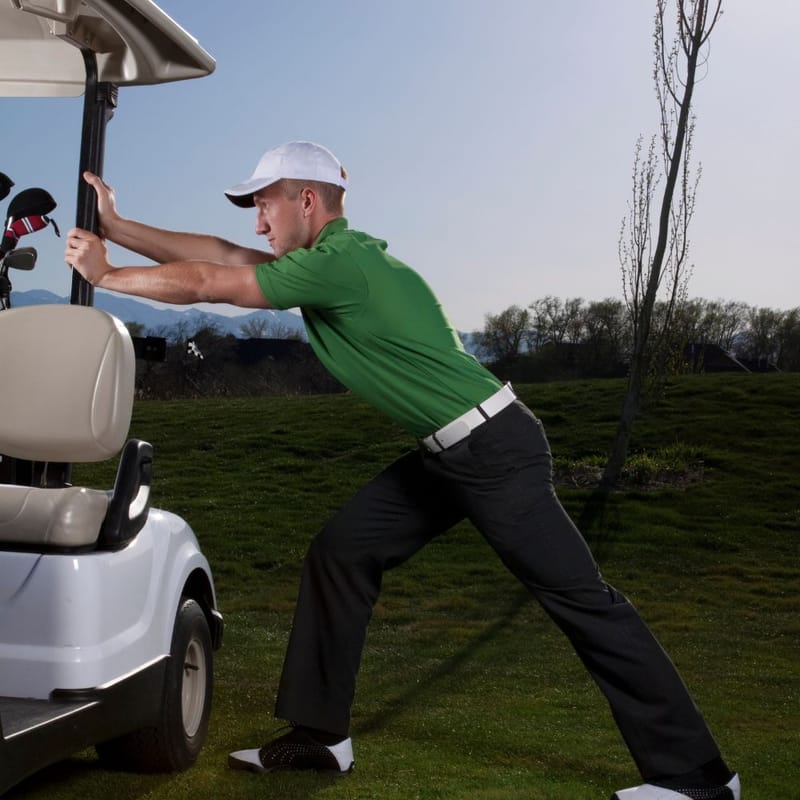Content Summary
The game of golf is a fascinating blend of precision, technique, and understanding the unique swing mechanics involved in hitting different clubs. One of the key aspects of the game that every amateur golfer needs to grasp is the difference between a driver swing vs iron swing.
The driver is the longest club in your bag, and as such, it requires a longer swing. When hitting your driver, the golf swing should be wide and sweeping, with the low point of your swing coming just before the ball.
This results in an upward angle of attack, which is ideal for maximizing distance on your driver shots. The golf stance for a driver also differs from that of an iron; for right hand golfers, your weight should be evenly balanced, and the ball should be positioned forward in your stance toward your left instep for right handers.
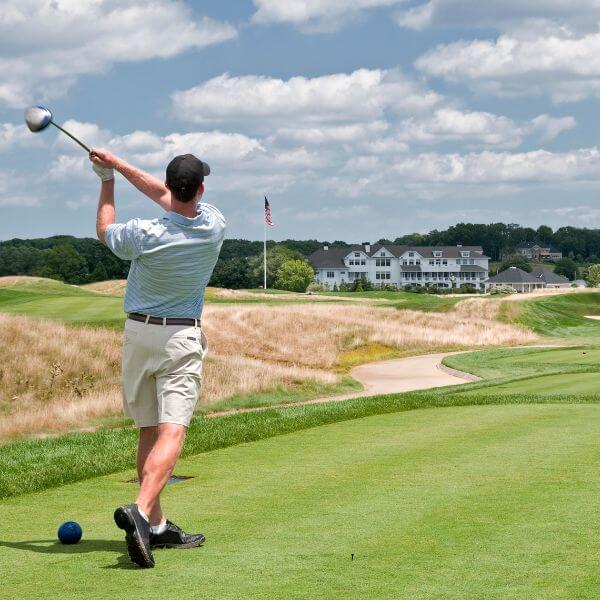
On the other hand, when you swing an iron, especially with short irons and wedges, the mechanics change. The swing motion is more upright and the attack angle changes to a descending motion.
This is because you want to strike the ball at the low point of your swing or even slightly after, especially when you hit a short iron. The weight distribution in your golf stance also shifts more towards the target.
Whether you're swinging a 5 iron or a driver, each type of swing requires specific swing tips to master. For instance, to improve your golf driver swing, focus on maintaining a steady swing speed and making a driver swing that follows through completely. For a solid iron swing, position the golf ball more centrally in your stance and aim to hit golf shots with a descending blow.
Understanding these different swings and knowing when to swing the club like an iron or like a driver is crucial to improving your game. So, take these aspects of the game into account, practice your swing and give yourself the best chance of hitting successful iron and driver shots.
Remember, every club, from the long iron to the short wedge, has its own unique swing requirements. Mastering these will significantly improve your golf performance.
The Difference Between Driver and Iron Swings
So, If you're new to golf, you were probably thinking that swinging a driver is the same as swinging an iron. After all, they look pretty similar, right? There are similarities between the two swings, but also some important differences.
The biggest difference between the two is that with a driver, you want to hit up on the ball, while with an iron, you want to hit down on the ball. When you swing a driver, your goal is to hit the ball as far as possible. You need to create a high launch angle and low spin rate.
That's why hitting up on the ball is so important. When you hit up on the ball with your driver, you increase your launch angle and decrease your spin rate. This will help you achieve maximum distance.
But, when you swing an iron (like a 7-iron or pitching wedge), your goal is typically accuracy and consistency rather than maximum distance. To achieve this accuracy and consistency, you want to hit down on the ball with your iron swing. This helps create more backspin on the ball which can help it stop quickly once it hits the green.
Driver Swing
Overview of the driver swing
The driver swing is arguably the most exciting shot in golf. It's the one that can send the ball flying hundreds of yards down the fairway, leaving you feeling like a pro. But how do you achieve that perfect driver swing?
Simply put, a good driver swing involves swinging up on the ball at impact. This creates a higher launch angle and less spin, allowing the ball to carry further in the air and roll out even farther once it lands on the fairway. Additionally, a proper driver swing demands speed - both in terms of clubhead speed and body rotation - to generate maximum power.
Importance of hitting up on the ball
Hitting up on the ball is crucial for maximizing distance with your driver because it promotes a high launch angle and low spin rate, which translates into more carry distance.
The goal is to hit slightly on an upward angle at impact with your clubface slightly opened to create lift. One common mistake many golfers make is trying to hit down on their drivers as they would with their irons. This can lead to too much backspin which negatively impacts overall distance off of tee shots.
Tips for maximizing distance with a driver swing
There are several tips you can follow for maximizing your distance with your driver swing. First, ensure that you have good posture by standing straight and not leaning too far forward or backward.
Second, grip your club lightly so that you don't lose power from excessive muscle tension or gripping pressure. Thirdly, during your backswing focus 80% on turning rather than lifting as this will give you more width & power through impact without sacrificing control or accuracy.
When starting your downswing clear away from your hips so they don't block rotation towards target line throughout follow-through period indefinitely. All of these tips will contribute to a smoother, more fluid swing and help you achieve the maximum distance off the tee.
Iron Swing
Overview of the Iron Swing
The iron swing is different from the driver swing in a number of ways. First, the club head is smaller, which means it's easier to control and make contact with the ball. Second, you'll want to hit down on the ball with an iron, whereas you want to hit up on the ball with a driver.
This is because hitting down helps create backspin which gives your shot more control. When taking your iron swing, you'll want to line up so that the ball is in line with your front foot. Then take a shallow divot just after striking through the ball (not before). It's also important to have good posture and alignment when swinging an iron. Be sure to keep your chest over the ball and your arms relaxed.
Importance of Hitting Down on the Ball
A common mistake golfers make when swinging their irons is trying to scoop or lift up at impact. However, this will cause you to make contact too high on the ball and lose distance and accuracy.
As mentioned earlier, hitting down helps create backspin which gives your shot more control. To hit down on the ball properly, focus on making contact with a descending blow rather than trying to lift it into the air. This will ensure that your clubhead makes solid contact with the ground after hitting through the ball.
Tips for Accuracy and Consistency with an Iron Swing
One key factor in achieving accuracy and consistency when using an iron is having good tempo throughout your swing. This means taking a smooth backswing followed by a controlled downswing while maintaining proper balance. Another tip for accuracy and consistency is paying attention to where you're looking during your swing.
Make sure you keep your eyes fixed on where you want to strike (the back of the golf ball) and don’t take your eyes off the ball until after it’s been struck. It’s also important to stay relaxed while swinging to avoid tensing up and causing unwanted results.
Practice with different types of irons to get a feel for how each one behaves. Some golfers find that they prefer certain clubs over others depending on the shot they are trying to make. Experiment and see what works best for you!
Discussion on how to adjust your swing for each club
To adjust your swing for each club, you need to pay attention to your setup position as well as your backswing and downswing. With a driver setup, position yourself farther away from the ball than with an iron setup.
Your stance should also be wider since you need more stability when swinging such a long club. You also want to tee up the ball higher so that it sits in line with your lead shoulder or higher. For an iron setup, position yourself closer to the ball since irons are shorter than drivers.
Your stance should also be narrower since stability is not as much of an issue here as it is with driving clubs. You’ll want to have more weight distributed towards your front foot since hitting down on the ball requires more forward tilt in your body position.
During both the backswing and downswing, you’ll need to adjust your swing plane to fit the type of club you’re using. With a driver, your backswing should be wider and flatter than with an iron since the driver requires a wider arc. With an iron, your backswing should be more upright since you need to hit down on the ball.
In terms of the downswing, with a driver, you want to make sure that you’re hitting up on the ball as mentioned before. This means that your hips should rotate towards the target while your shoulders stay back during impact.
With an iron, you want to hit down on the ball so that it strikes the ground before taking off into flight. This means that you’ll need to shift your weight forward through impact and create a divot after striking the ball.
Common Mistakes in Driver and Iron Swings
The Slice
One of the most common mistakes golfers make with their driver swing is the slice. This occurs when the ball curves from left to right (for right-handed golfers). The cause of a slice usually comes from an outside-to-in swing path, which is when your clubface is open to your swing path at impact.
To avoid slicing, try closing your clubface slightly and aiming further left. You also want to make sure you're swinging on an inside-to-out path to encourage a draw. With iron swings, one of the most common mistakes is hitting thin shots.
This occurs when you hit the ball too high on the face or don't hit down enough on the ball. To avoid this mistake, make sure you're hitting down on the ball with a descending blow and contacting it in the center of your clubface.
The Hook
The hook is another common mistake that golfers make with their driver swing. This happens when the ball curves excessively from right to left (for right-handed golfers).
The cause of a hook usually comes from an inside-to-out swing path, which closes your clubface too much at impact. To fix a hook, try opening up your clubface and aiming further right. You also want to focus on swinging more outside-in. With iron swings, another common mistake is hitting fat shots.
This happens when you hit too far behind the ball or don't transfer enough weight forward through impact. To avoid this mistake, try focusing on keeping your weight forward throughout your swing and making contact with the ground after striking the ball.
Ball Positioning
Another common mistake golfers make with both their driver and iron swings is incorrect ball positioning in their stance. With drivers, some players position their balls too far forward, while others position them too far back.
For irons, some players position their balls too far back in their stance, while others position them too far forward. To avoid this mistake, make sure you're positioning the ball correctly for each club.
Generally speaking, the ball should be positioned closer to your lead instep for your driver swing and center or slightly left of center for your iron swing. Spend some time practicing these tips before your next round to see improvement in your swing.
Practice Drills for Improving Your Driver and Iron Swings
Drills to Improve Your Driver Swing
If you're looking to improve your driver swing, there are a few drills you can try. One of the most popular is the tee drill. Simply place a tee in the ground in front of your ball and try to hit the tee on your downswing.
This will help you focus on hitting up on the ball and getting more distance. Another drill is the alignment stick drill. Place an alignment stick along your target line, parallel to your feet. Then, practice swinging just outside of the stick (without hitting it) to ensure that you're making a straight path towards your target. Try practicing with different clubs than your driver.
You can use a pitching wedge or 7 iron and focus on keeping a smooth tempo throughout your swing. This will help prevent any jerky movements that can negatively impact your driver swing.
Drills to Improve Your Iron Swing
Improving your iron swing takes a bit more finesse than improving your driver swing. One drill that can help is hitting half shots with a shorter club like an 8 iron or 9 iron.
Focus on taking shorter swings with good tempo and getting solid contact with the ball. Another useful drill is practicing with just one arm at a time. Start by hitting shots with just one arm then switch over to using both arms once you've developed more control over each individual arm.
Work on controlling distance through consistent swings by placing different targets at varying distances from where you're hitting from (think short game). Hitting balls at these targets regularly will develop consistency as well as create muscle memory for different distances.
Suggestions for drills to improve technique with both clubs
To truly hone in on improving both swings, there are some drills that can benefit both your driver and iron swings. One of the most versatile exercises is the use of a weighted club.
Practice swinging a weighted club to build muscle memory and develop strength in your swing. Another useful drill is practicing with your eyes closed. While it may seem counterintuitive, doing so can help you focus on the feel of each swing without being distracted by visual cues.
Try incorporating video analysis into your practice routine. Recording yourself from different angles will provide valuable insights into your technique and help identify areas where you can improve.
By including these drills in your practice routine, you'll be able to improve both your driver and iron swings while building consistency and distance control.
Conclusion
Understanding the differences between your driver and iron swing is crucial for improving your overall golf game. The driver swing requires hitting up on the ball to maximize distance, while the iron swing requires hitting down on the ball for accuracy and consistency.
By adjusting your swing for each club, you can improve your technique and avoid common mistakes that plague many golfers. Keep a loose grip, maintain good balance, and follow through fully to increase distance. For iron shots, focus on hitting down on the ball and taking a divot after impact. Positioning the ball center in your stance will help achieve this.
Maintain good posture throughout your swing, keeping your head still and eyes focused on the ball. Practice drills such as hitting off of different lies or using alignment aids can help improve both driver and iron swings. But most importantly, be patient with yourself as you work to improve.
Golf is a challenging sport that takes time to master. By implementing these tips into your practice routine and understanding how each club should be used differently in terms of swinging mechanics, you'll be well on your way to a better golf game. Remember to have fun out there.
Thank you for visiting, and we hope to see you back soon!
